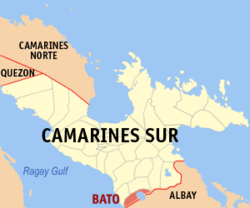Bato, Camarines Sur
| Bato | ||
|---|---|---|
| Municipality | ||

Municipal hall
|
||
|
||
 Map of Camarines Sur showing the location of Bato |
||
| Location within the Philippines | ||
| Coordinates: 13°21′22″N 123°21′50″E / 13.3561°N 123.3639°ECoordinates: 13°21′22″N 123°21′50″E / 13.3561°N 123.3639°E | ||
| Country | Philippines | |
| Region | Bicol (Region V) | |
| Province | Camarines Sur | |
| District | 4th district | |
| Barangays | 33 | |
| Government | ||
| • Mayor | Frank Bernaldes | |
| Area | ||
| • Total | 107.12 km2 (41.36 sq mi) | |
| Population (2015 census) | ||
| • Total | 52,137 | |
| • Density | 490/km2 (1,300/sq mi) | |
| Time zone | PST (UTC+8) | |
| ZIP code | 4435 | |
| IDD : area code | +63 (0)54 | |
| Income class | 3rd class; partially urban | |
Bato (Rinconada Bikol: Banwāan ka Bato; Tagalog: Bayan ng Bato) is a third class rural municipality in the province of Camarines Sur, Philippines. According to the 2015 census, it has a population of 52,137 people.
The municipality of Bato, like Buhi town, is home to a lake teeming with various kinds of fishes. Sinarapan, the world's smallest commercially harvested fish, occupies the waters of Lake Bato. Also present, the lake abounds with tilapia housed in fish cages.
This town was formerly called as "Kaliligno" or "Caligno" named by the natives that settled along the river area. See also, the Bato's native Pre-Spanish Era Early Settlers.
This small village later was elevated into a status of a town under the decree of Spanish Superior Government on February 15, 1753. Years back, a parish was already existing which was also made under the same decree. This parish adopted "The Most Holy Trinity" as its patron; its feastday is celebrated every Sunday after the Pentecost.Known for best noodles called pansit bato.
Bato is politically subdivided into 33 barangays.
In the 2015 census, the population of Bato, Camarines Sur, was 52,137 people, with a density of 490 inhabitants per square kilometre or 1,300 inhabitants per square mile.
Only about 58.27% of the household population is considered as literate.
Mother tongue of the majority is Riŋkonāda also known as Bikol Rinconada, one of the languages of Bicol region. The population speaks a different form of Rinconada Bikol called Bato variant, a lowland dialect (sinaranəw). Natives are also conversant with Coastal Bikol, Filipino/Tagalog and English languages.
Religious affiliation:
Majority of employment is within agriculture, fishery, poultry and construction industry groups.
Commerce and industry:
Natural resources include clams, pearls, local shrimps, tabios, and tilapia, particularly within Lake Bato; forest products such as anahaw leaves and local bamboo; non-metallic mineral resources such as white clay among others.
...
Wikipedia


